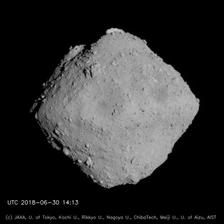Asteroid Ryugu photographed from 20 kilometres away by the Japanese space probe Hayabusa 2. (Credit: JAXA, University of Tokyo, Kochi University, Rikkyo University, Nagoya University, Chiba Institute of Technology, Meiji University, University of Aizu and AIST)
In a spectacular mission, the Japanese space probe Hayabusa 2 collected rock samples from the surface of asteroid Ryugu and brought them back to Earth in December 2020. A large international team is now analysing the extraterrestrial material. Researchers Frank Brenker from Goethe University Frankfurt am Main, Laszlo Vincze from Ghent University and Gerald Falkenberg from DESY and their teams were among the first to literally screen the precious samples, among others also at DESY's X-ray light source PETRA III. The international research collaboration led by Tomoki Nakamura from the University of Tohoku is now presenting its first analyses in the journal Science.
The teams around Vincze and Brenker are world leaders in a method that makes it possible to examine the chemical composition of material in all three spatial directions with the help of X-rays in a completely non-destructive way and without any complex sample preparation – and with a detail accuracy of less than 100 nanometres (a nanometre is a millionth of a millimetre). The method is called Synchroton Radiation induced X-Ray Fluorescence Computed Tomography, or SR-XRF-CT for short.
The Japanese space agency JAXA had chosen Ryugu (“the palace of the Dragon King”) as the probe's target because it is an asteroid which, due to its high carbon content, promised to provide a particularly large amount of information about the origin of life in our solar system. The analyses on 16 particles now show that Ryugu belongs to the class of CI asteroids, which are extremely similar to the Sun in their chemical composition. Material from these CI asteroids has only rarely been found on Earth so far – and it was unclear how much these specimen had been altered or contaminated by entering Earth's atmosphere as well as impacting Earth. In addition, the analysis confirms the assumption that Ryugu originated from a parent asteroid that formed in the outer solar nebula.
Until now, scientists assumed that due to the low temperatures during the formation of the CI material in the early days of the solar system, there was hardly any material transport within the asteroid and thus hardly any chance for the massive enrichment of elements. However, Brenker's team used SR-XRF-CT to find a fine vein of magnetite – an iron oxide mineral – and hydroxyapatite, a phosphate-containing mineral, in one of the asteroid's grains. Other research groups determined that the structure and other magnetite-hydroxyapatite regions in the Ryugu samples must have formed at a surprisingly low temperature of below 40 degrees Celsius. This finding is essential for the interpretation of almost all the results that the study of the Ryugu samples has produced and will produce.
Brenker's team also detected rare earth metals in hydroxyapatite-containing areas of the samples – a group of chemical elements that is nowadays indispensable for alloys and glasses in high-tech applications, among other things. “The rare earths occur in the hydroxyapatite of the asteroid in concentrations 100 times higher than anywhere else in the solar system,” says Brenker. In addition, all elements of the rare earth metals are enriched to the same extent in the phosphate mineral which is also unusual. “This equal distribution of rare earths provides further evidence that Ryugu is a very pristine asteroid representing the beginnings of our solar system,” Brenker explains.
The analyses now presented are just the beginning of the evaluation. Measurements on the precious samples have not yet been completed. “It is an extraordinary experience to X-ray extraterrestrial material. These are not everyday samples,” says Falkenberg, who heads the P06 measuring station at PETRA III at DESY. “We are very excited to see what else the asteroid samples have in stock for us. Surprising findings are definitely awaiting!”
(from DESY News)
Reference:
Formation and evolution of carbonaceous asteroid Ryugu: Direct evidence from return samples; Tomoki Nakamura et al.; Science, 2022; DOI: 10.1126/science.abn8671
Further reading:
Release from the Japanese space agency JAXA.
Release from Goethe University Frankfurt am Main.







